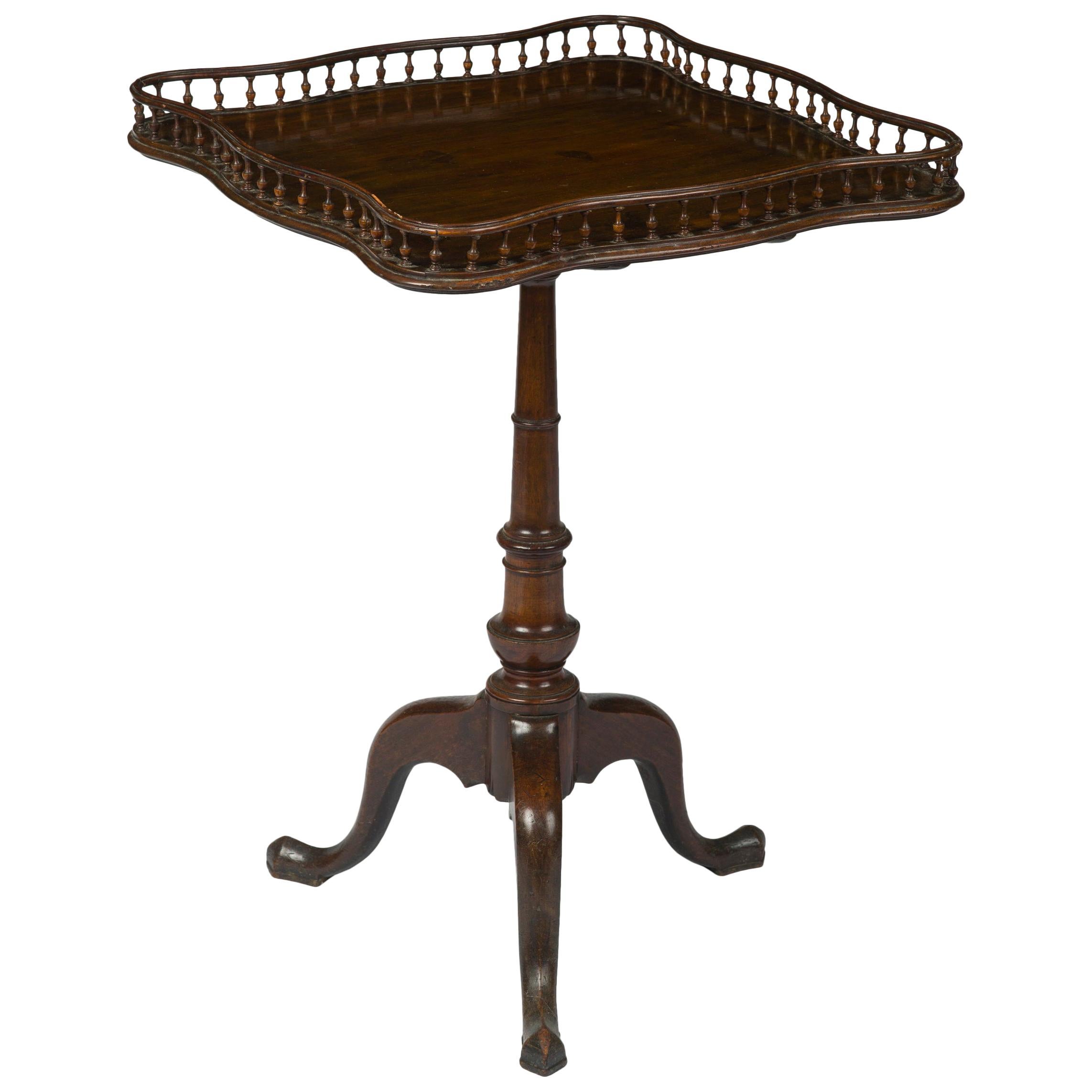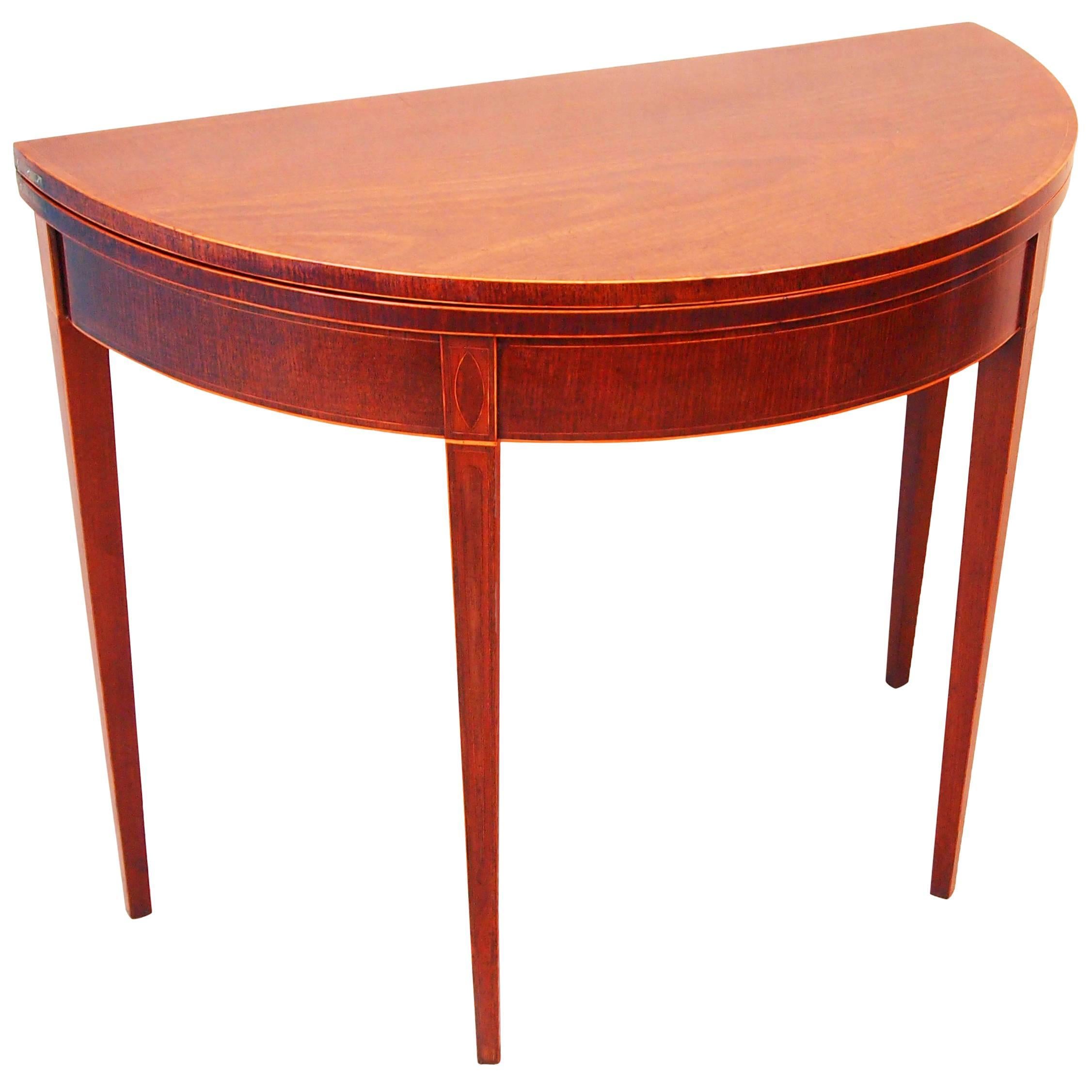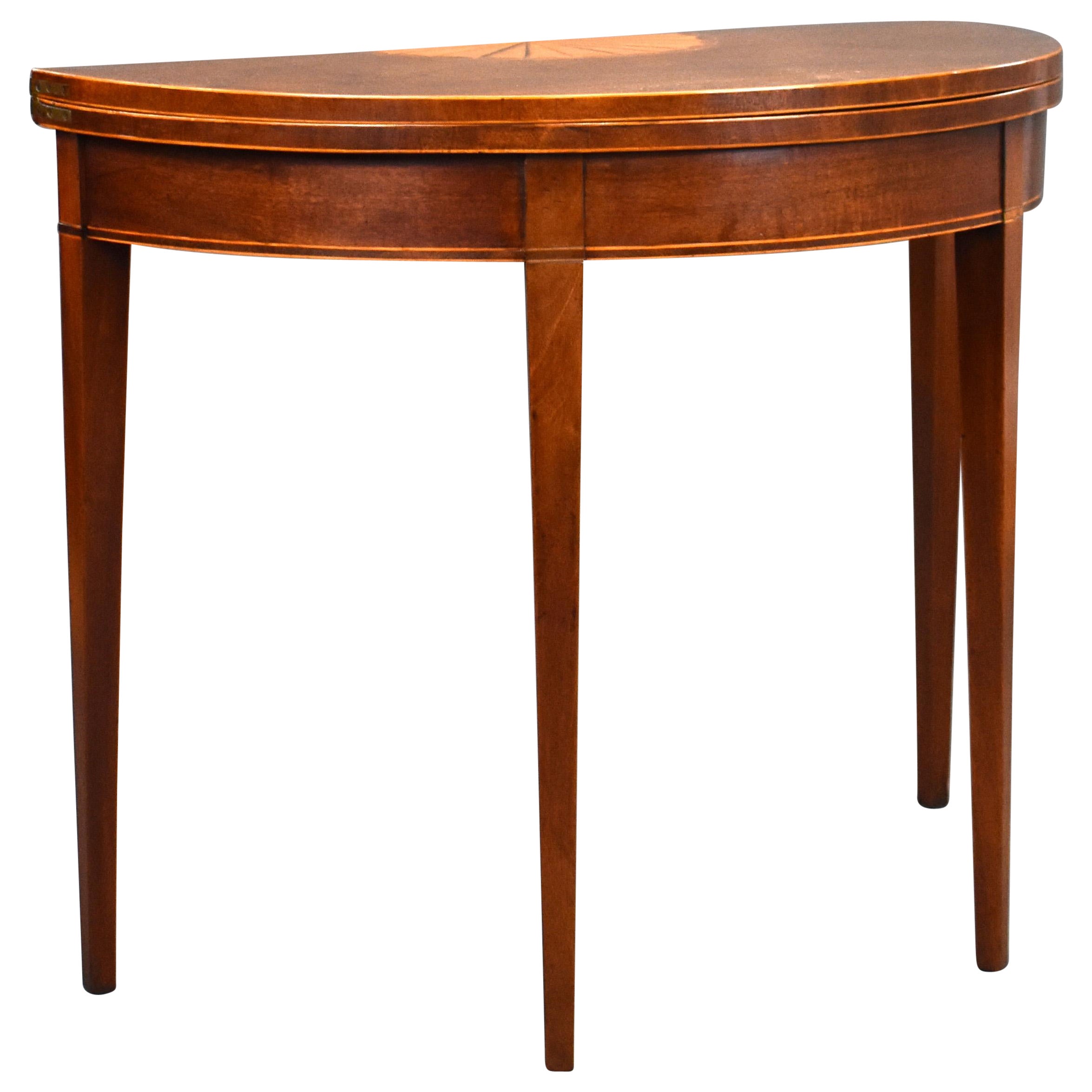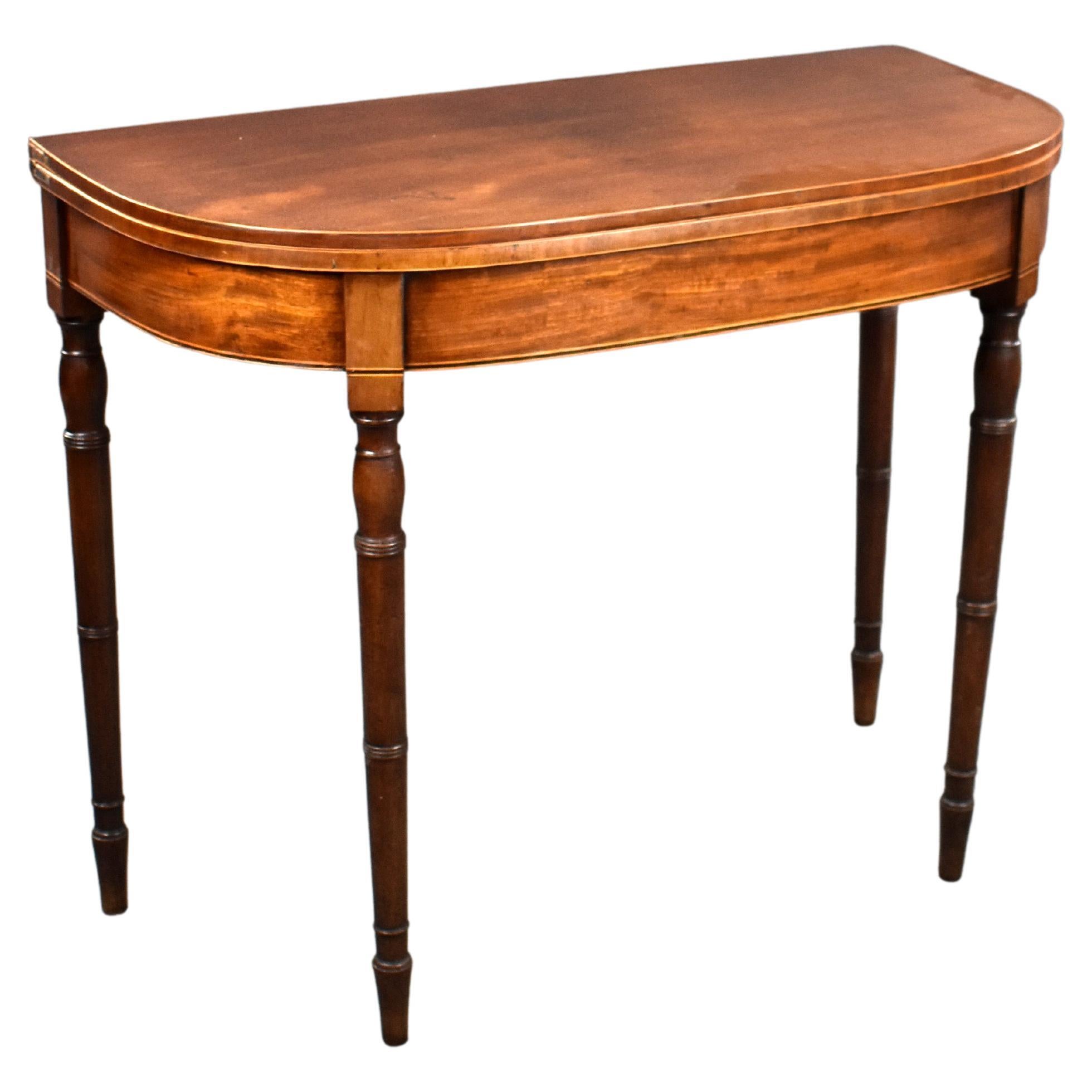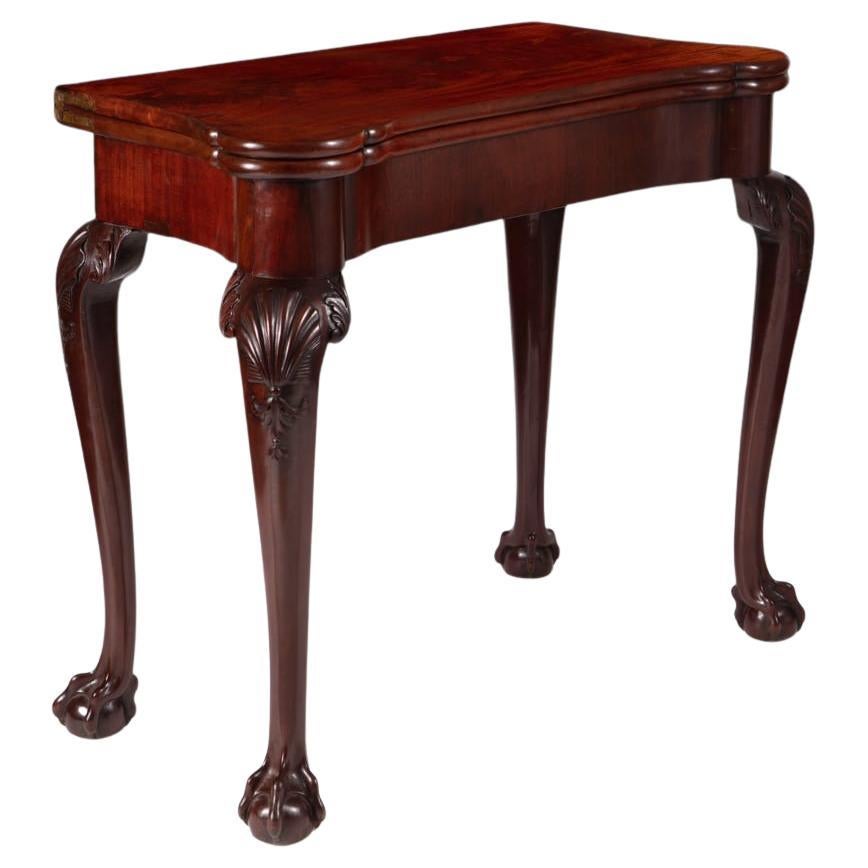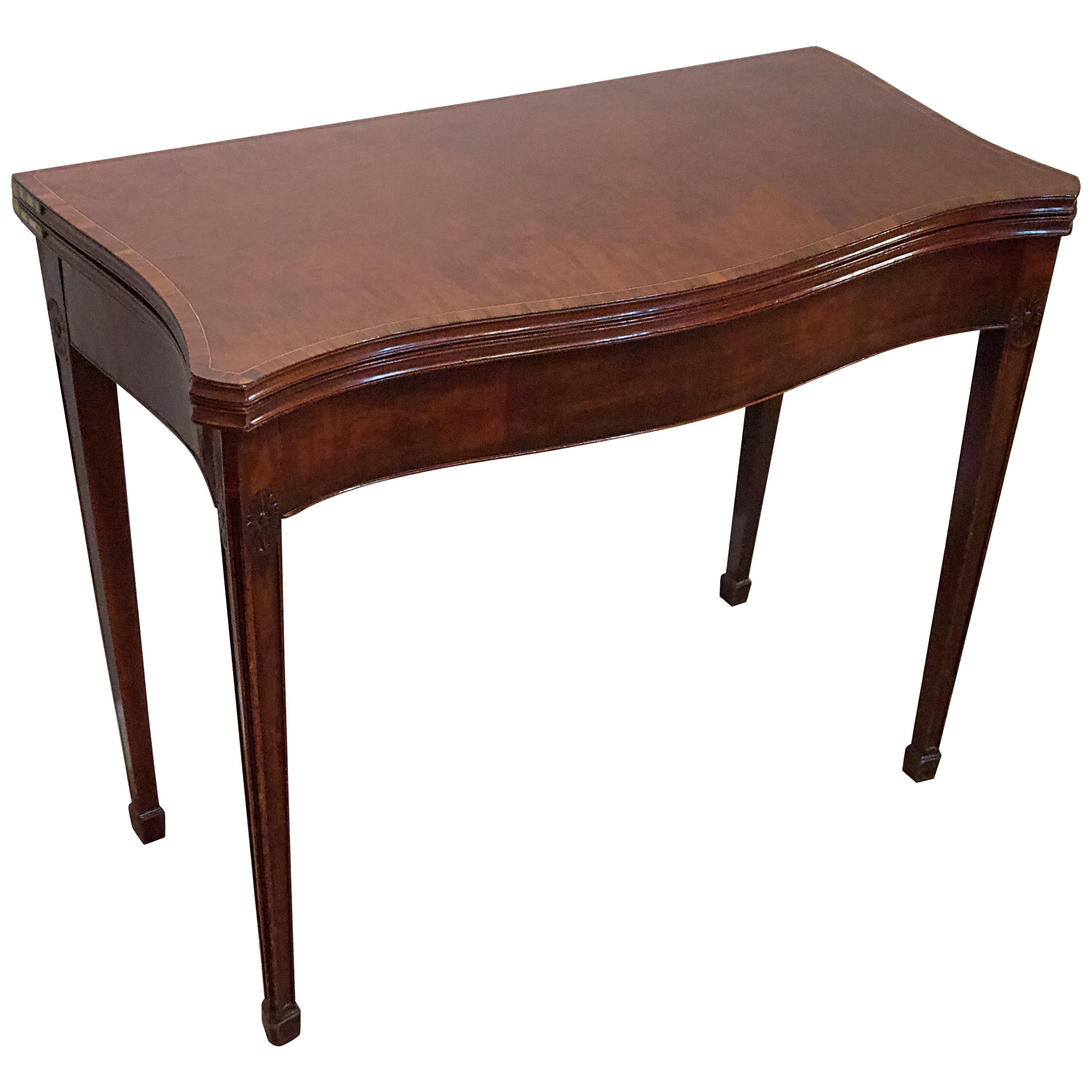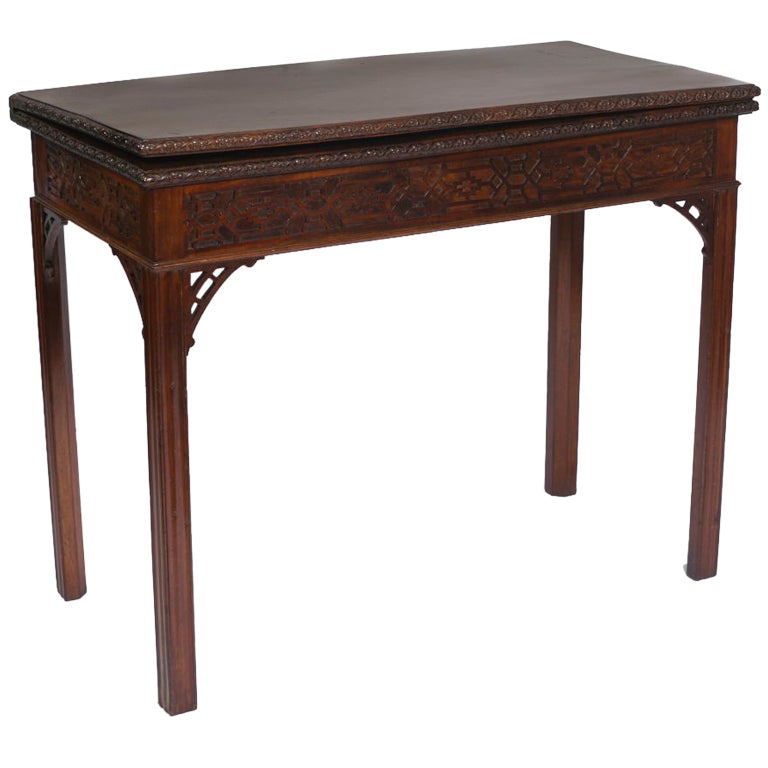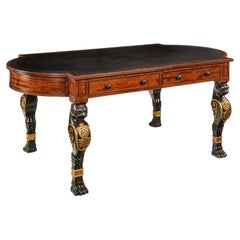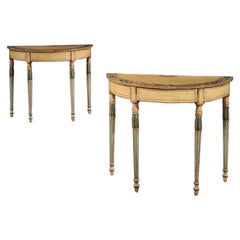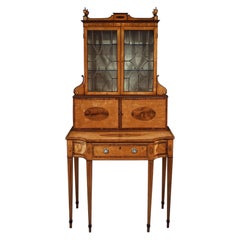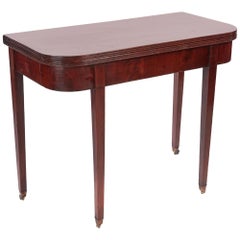
George III Mahogany Demilune Tea Table
View Similar Items
Want more images or videos?
Request additional images or videos from the seller
1 of 11
George III Mahogany Demilune Tea Table
About the Item
- Dimensions:Height: 28.25 in (71.76 cm)Width: 38.75 in (98.43 cm)Depth: 17.75 in (45.09 cm)
- Materials and Techniques:
- Period:
- Date of Manufacture:circa 1800
- Condition:
- Seller Location:Benington, GB
- Reference Number:Seller: 20121stDibs: LU118322784112
About the Seller
5.0
Vetted Seller
These experienced sellers undergo a comprehensive evaluation by our team of in-house experts.
Established in 1969
1stDibs seller since 2015
112 sales on 1stDibs
Associations
LAPADA - The Association of Arts & Antiques DealersThe British Antique Dealers' Association
More From This SellerView All
- Important Regency Mahogany Partners Writing Table in the Manner of George SmithBy Charles Norman, George SmithLocated in Benington, HertsA highly Important, Early Regency period mahogany, ebonised and parcel-gilt partners writing table on monopodia legs of exceptional quality and design, in the manner of George Smith, stamped Chas Norman, whom was associated with the work of Gillows. Labelled ‘Morning Room’. English, Regency period, circa 1810. Rarely seen, the crescent shaped ended rectangular top, beautifully lined with the original gilt tooled leather writing surface, enclosed by a mahogany cross-banded border and reeded edge. The frieze, containing four finely chosen fiddle-back mahogany drawers, two pairs to opposing sides, each retaining the original gadrooned carved ebonised knob handles. The perimeters having a finely ebonised cockbead, whilst the drawer liners being executed in mahogany retain the original recessed brass locks, which look to have never been removed. Flanking the drawers are bead-moulded ebonised panels which conform to either end above a reeded mould. Raised on four boldly designed and imposing, crisply carved, ebonised and parcel-gilt leopard monopodia supports, of wonderful original waxed condition. The Egyptian leopards mask above a bold breast decorated with carved gilt anthemion and guilloche motifs, finishing on a finely detailed carved leg and paw foot. The condition is excellent, retaining the original hand-dyed and gilt tooled waxed leather writing surface along with original locks, handles and ebonising with gilt-work to the legs. Commissioned for what presumes to be a private collection and due to its condition, being obvious to see, this writing table has been home to an important household. Labelled ‘Morning Library’ to the underside, whilst in this exemplary condition strongly suggests this striking piece of Regency furniture has furnished the library of the said house for the majority of its life. As can be noted, this is an extremely rare, elegant, early Regency writing table of exceptional colour, which corresponds with designs of the celebrated furniture maker and designer George Smith, workmanship of Gillows, being stamped to the underside Chas Norman four times. George Smith (1756 - 1826) was one of the most influential furniture designers of the English Regency Period (1811-1830). Smith, who began his pattern-book in 1804, wrote of ‘the great taste and elegance’ of this design. In 1808 he published his influential and definitive text on Regency interior Design titled ‘ A Collection of Designs for Household Furniture and Interior Decoration’ and classed himself as ‘Upholder Extraordinary to His Royal Excellency the Prince of Wales’…The Prince Regent. Smith was inspired in his designs from his earlier career as an Egyptologist, producing drawings incorporating motifs of Leopards heads and paws, Lions, sphinx’s, anthemia, and griffons amongst others. Charles Heathcote Tatham (1772-1842) published ‘Etchings, Representing the Best Examples of Ancient Ornamental Architecture; Drawn from the Originals in Rome, and Other Parts of Italy During the Years 1794, 1795, and 1796’, in which he illustrated an antique tripod table...Category
Antique 1810s British Regency Desks and Writing Tables
MaterialsMahogany, Giltwood
- Fine Pair of Georgian Painted Demilune Pier TablesBy SeddonLocated in Benington, HertsA very fine pair of late 18th century original painted demilune pier tables reminiscent of the work of Seddon, Sons and Shackleton. English circa 1795. An elegant and rare pair...Category
Antique 1790s British Georgian Demi-lune Tables
MaterialsWood, Paint
$15,838 Sale Price / set25% Off - An Important 18th Century George Iii Satinwood and Sabicu Writing CabinetLocated in Benington, HertsA fine late 18th Century George III Satinwood and sabicu ladies writing cabinet with important provenance. (Possibly by George Simpson) English London made - Circa 1785 Provenance Exhibited by W. R. Harvey in their Old Bond Street showrooms in 1986 and 1987, the piece being chosen to be advertised in Country Life magazine in 1986 and in the Grosvenor House...Category
Antique 1780s English George III Cabinets
MaterialsSatinwood
- Fine 19th Century Mahogany Leather Upholstered Wingback Armchair in the George ILocated in Benington, HertsA well proportioned and substantial late 19th century carved mahogany wing-back armchair in the George II manner upholstered in a tan leather. English circa 1880. A fine quality and well drawn carved mahogany wing chair inspired by William Kent of the early 18th Century. Upholstered in a hand dyed natural leather with a feather cushioned seat, having grand proportions making this a very comfortable reading chair. The shaped sides with scrolled arms being finished with brass stud work, upon a finely carved mahogany base having a central satyr mask surrounded by foliage and ribbons raised on hipped cabriole legs with shell to the knee terminating on ball and claw feet. This impressive antique leather chair...Category
Antique 1880s English George II Armchairs
MaterialsLeather, Mahogany
- An Exceptional George Iv Period Boulle Games Table Attributed to Thomas ParkerBy Thomas ParkerLocated in Benington, HertsAn Exceptional Boulle and Ormolu Mounted Games Table in the French Louis XVI style attributed to Thomas Parker (active 1805-1830) English Circa 1825 C...Category
Antique 1820s English Louis XVI Game Tables
MaterialsOrmolu
- Fine Burl Amboyna and Marquetry Centre Table Attributed to George Blake and Co aBy George Blake & Co.Located in Benington, HertsA Fine Burl Amboyna and Marquetry Centre Table Attributed to George Blake and Co and Probably Retailed by Edward Holmes Baldock English London made Circa 1845. An exceptional table of wonderful colour, utilising the finest amboyna veneers as a background for a complex pattern of floral marquetry on the stem, feet and table top. The tilt-top with segmented veneers and central floral inlay within an inlaid floral scroll surround and with a conforming inlaid outer border. The triform pedestal base with foliate inlay, carved leaf scroll feet with carved lateral flower head roundels with recessed castors. The basic design for this table comes from the work of the designer Richard Bridgens and was published in 1838 as plate 16 in his Furniture with Candelabra. As can be seen from the image of Bridgens' design, the outer scrolling border on the top of our table is very much in the style of that suggested in the design but the other marquetry is of a sophisticated floral type popularised slightly later, suggesting a date of c.1845 for our table. Marquetry of this sort was a speciality of the Blake family, marquetry experts and associates of the great dealer Edward Holmes Baldock. Baldock was responsible for building some museum quality collections of fine 18th century French furniture during this period for some of his famous aristocratic clients but he also supplied new furniture in the French taste, often incorporating marquetry by the Blake firm. The use of exotic amboyna as the ground for this marquetry is also in keeping with other pieces known to have been supplied by Baldock, for whom it appears only the best was good enough. The sinuous lines of this table and the exotic veneers give the piece a more timeless feel than many other examples from this period and the colour means that it would work equally well in a contemporary interior or alongside pieces of Art Deco furniture as it would in a more traditional room. This is a piece of sublime quality that somehow manages to be both decorative and yet understated and as such is exactly the sort of piece we enjoy sharing with our clients. Edward Holmes Baldock (1777-1845) Born on the 14th May 1777 he established his business in 1805 in Hanway Street which over the years he expanded at this location. He soon was a prominent London furniture dealer to several members of the Royal Family and is responsible for supplying French-fashioned furniture to the 5th Duke of Buccleuch. Edwards Holmes Baldock’s pieces have become a prized possession amongst collectors, museums and dealers alike. The use of a variety of specimen woods can often been seen on attributed and signed tables by Edward Holmes Baldock, reminiscent of those on the present table. Baldock was thought to have worked very closely to with the master of marquetry and inlay of the 19th Century Robert Blake who had workshops adjacent to Baldock’s retail premises. Pieces in public collections with likely links to the Blake Family include a piano in the Metropolitan Museum of Art, a writing desk in Goodwood House, a centre table in Syon House, a circular table in Alnwick Castle, an octagonal table in the Leeds City Art Gallery at Temple Newsam House and also signed works in the Victoria and Albert Museum. Baldock's works often imitated the important pieces of 18th-century French furniture that Francophile collectors including George, Prince of Wales, later George IV, William Beckford, Francis Seymour Conway, 3rd Marquess of Hertford and George Watson...Category
Antique 1840s European Center Tables
MaterialsBurl, Amboyna
You May Also Like
- Antique George III Mahogany Tea/Side TableLocated in Suffolk, GBGeorge III antique mahogany tea/side table with a stunning mahogany top, reeded edge, gateleg support for the hinged fold over top, shaped frieze, standing on four square legs with o...Category
Antique Late 19th Century English George III Card Tables and Tea Tables
MaterialsMahogany
- George III Mahogany Tilt-Top Tea TableLocated in Kittery Point, METhe square serpentine tilt-top with a spindle gallery, above a tapering turned column raised on three cabriole legs terminating in pad feet.Category
Antique Late 18th Century English George III Card Tables and Tea Tables
MaterialsMahogany
- George III Mahogany Tilt Top Tea TableLocated in Essex, MAWith circular shaped spindled gallery raised on a turned urn form support and three cabriole legs with pad feet. Provenance; Devenish Antiques, NYC.Category
Antique 1760s English George III Card Tables and Tea Tables
MaterialsOther
- Antique Georgian Mahogany Demilune Tea TableLocated in Bedfordshire, GBA good quality late 18th century mahogany demilune shaped tea table of Excellent color and patina with inlaid and banded decoration raised on Elegant square tapered legs.Category
Antique Late 18th Century English George III Card Tables and Tea Tables
MaterialsMahogany
- George III Satinwood Demilune Games TableLocated in Essex, MAHinged demilune with crossbanded edge and inner fan inlay, frieze with similar inlay raised on square tapered legs.Category
Antique 1790s English George III Demi-lune Tables
MaterialsSatinwood
- 19th Century English George III Mahogany Tea TableLocated in Chelmsford, EssexFor sale is a George III Mahogany tea table, having a shell inlay to the top, opening out to make a circular table, standing on tapered l...Category
Antique Early 19th Century English George III Card Tables and Tea Tables
MaterialsMahogany

